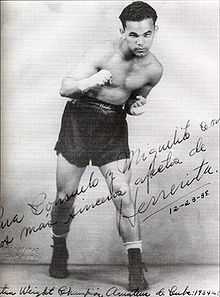Miguelito Valdés
Miguelito Valdés, born Miguel Ángel Eugenio Lázaro Zacarias Izquierdo Valdés Hernández or Eugenio Lazaro Miguel Izquierdo Valdes y Hernandez[1] (Havana, Cuba, 6 September 1912 – Bogotá, Colombia, 9 November 1978), also called Mr. Babalú, was a Cuban popular singer of high quality. His performances were characterized by a strong voice and a particular sense of cubanismo.
Life
In origin, he was a mestizo of a Spanish father and a Mexican Yucatec mother. He was born in the largely black barrio of Belén in La Habana Vieja, and moved to another barrio, Cayo Hueso (in Centro Habana), when his father died. In his youth he worked as an auto mechanic and was a good amateur boxer. In 1934 he won the Amateur Championship of Cuba at his weight. One of his closest friends from his days in the barrio was Chano Pozo, and in his singing style he has been called "as black a white guy as you would meet in Havana".[2]
Career
He got his start in the night clubs of Havana, and first attracted renown as vocalist at the Havana-Riverside Casino. Miguelito began his musical career in the Sexteto Habanero Infantil, where he played, variously, the guitar, tres, double bass, timbal and sometimes sang. Soon, his capability as a singer was realized, and from that moment he was constantly in demand. After a brief spell with María Teresa Vera's Sexteto Occidente, he was one of the founding members of the Septeto Jóvenes del Cayo in 1929. In 1933 he moved to the charanga of Ismael Díaz, and then to the Charanga Gris, directed by the pianist and composer Armando Valdés Torres, and to the Orquesta Habana, directed by Estanislao Serviá.[3]

In 1934, he made his first journey abroad, to Panama, and on his return joined the Orquesta Hermanos Castro, which was a leading band of the day. He was their lead singer until 1936. In 1937, he joined a group of top musicians who formed the Orquesta Casino de la Playa. He was now perhaps the top singer in Cuba, on the verge of international fame. In 1939, La Playa toured South America and Central America, and started a series of recordings for RCA-Victor which would make them famous throughout the world.
In 1940, Valdés briefly joined the Orquesta Riverside (another of the big Cuban bands) before emigrating to New York City, which became his home base for the rest of his career. In New York he worked for Orquesta Siboney de Alberto Iznaga, Xavier Cugat, Noro Morales, Tito Rodríguez and Machito. He directed his own orchestra for a few years, and made some successful recordings with it in 1949/50.[4] He appeared with Brazilian singer Delora Bueno (1925-1912) in her DuMont Television Network program Flight to Rhythm (March to September 1949).
He appeared in a number of films, and was known as "Mr. Babalú" after his performance of Margarita Lecuona's Babalú. Miguelito recorded this number with three top orchestras: Casino de la Playa in Havana, and Xavier Cugat and Machito in New York. He recorded with the renowned band Conjunto Sonora Matancera in 1951 and 1977.[5][6] Miguelito was regarded as one of the greatest soneros and guaracheros[7] in Cuban music. Although non-African, his interpretation of Afro-Cuban lyrics was remarkable. He died from a heart attack during a performance in Bogotá, Colombia.[8] In 1960, he organized a revue "Mr. Babalu", which performed in Reno, Nevada and Lake Tahoe, California. Billed were singers Loraine Barry, Marguerita Monteil and Josie Powell. (Please see "Tito Puente: When the Drums are Dreaming".) By Josephine Powell, Author House, 2007
Numbers he composed include Mondongo, Rumba rumbero, Loco de amor, Los tambores, Oh, mi tambó, Bongó, Dolor cobarde. Films he appeared in include Mi reino por un torero; Suspense, Panamericana, Imprudencia, Acapulqueña (with María Antonieta Pons), Copacabana, Mientras el cuerpo aguante, Canción para recordar and Nacido para amarte. Also listed is Bailando nace el amor (with Fred Astaire and Rita Hayworth) in 1942, which may be the Spanish-language version of You Were Never Lovelier.
References
- ↑ Billboard April 25, 1942
- ↑ Sublette, Ned. Cuba and Its Music: From the First Drums to the Mambo, p. 440. Chicago, Ill. 2004.
- ↑ Giro, Radamés. Diccionario Enciclopédico de la Música en Cuba. Vol 4, p. 252. La Habana, Cuba. 2007.
- ↑ Miguelito Valdés with His Super Orchestra: Mambo Dance Session. Historical 1949 Recordings. Caribe Classics CC1050CD, 22 numbers.
- ↑ http://www.wikipedia.org, English language website, Sonora Matancera.
- ↑ http://www.wikipedia.org, Spanish language website, La Sonora Matancera.
- ↑ sonero: lead singer of sones; guarachero: lead singer of guarachas.
- ↑ Salazar, Max. "The Miguelito Valdés Story". Latin Beat, New York. March 1992.
8. Powell, Josephine Tito Puente: When the Drums are Dreaming, Authorhouse , Indianapolis, 2007
External links
- Source of the clip from YouTube is probably a film short. The singer is definitely Miguelito Valdés; insipid backing group is claimed to be Orquesta Casino de la Playa. Date and place of recording not known.
|
